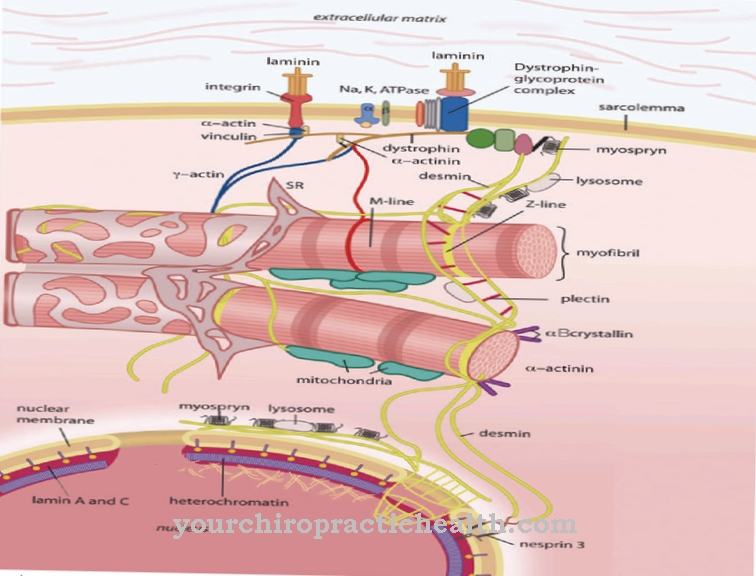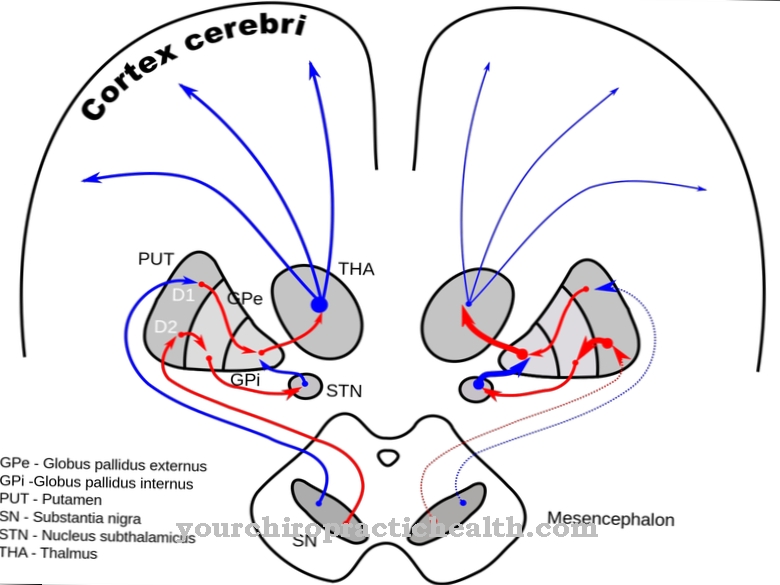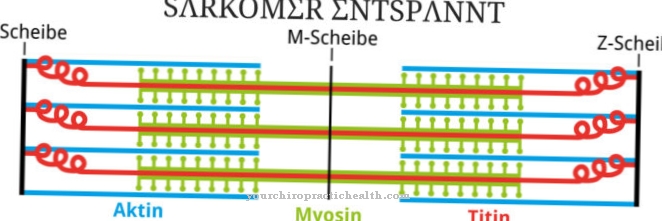Of the Psoas major muscle is a skeletal muscle of the hip muscles also known as the large lumbar flexor. The hip muscle is involved in flexion as well as internal and external rotation in the hip joint and plays a role in the lateral flexion and inclination of the lumbar spine. Damage to the femoral nerve paralyzes the psoas major muscle.
What is the psoas major muscle?
The hip muscles are a group of skeletal muscles in the area of the hip joint. The hip muscles wrap around the hip joint and are attached to the proximal part of the thigh bone. Topographically and functionally, the hip muscles are divided into an inner, an outer and a deep part.
The psoas major muscle corresponds to a skeletal muscle of the inner hip muscles. Together with the iliacus muscle, the hip muscle forms the functional unit of the iliopsoas muscle, which is located in the retroperitoneal space. The psoas major muscle can be subdivided into a superficial and a deeper layer, which have different origins. The superficial layer arises from the twelfth thoracic vertebrae, the first lumbar vertebrae and the intervertebral discs assigned to them. The deep layer has its origin in the transverse processes of the lumbar vertebrae. In the German literature, the psoas major muscle is also dated large lumbar muscle the speech.
Anatomy & structure
The psoas major muscle is located in close proximity to the lumbar plexus. In addition to the direct branches from L1 to L4 of the lumbar plexus, the femoral nerve takes over the motor innervation of the hip muscle. The psoas major muscle, together with the iliacus muscle, starts at the lesser trochanter of the thighbone (femur).
The superficial part and the deep part of the large lumbar muscle unite with the iliac muscle. Together, the muscles are enveloped by fascia and in this unit are called the lumbar and iliac muscles. The lumbar bone muscle enters through the so-called muscle port (Lacuna musculorum), where it reaches the small rolling hillock (lesser trochanter) of the femur. The psoas minor muscle usually rests on top of the psoas major muscle. In the human body, this muscle is extremely variable and is sometimes replaced by fascia. One of the important features of the psoas major muscle is the visibility of the tissue on X-rays. Signals from the central nervous system reach the psoas major muscle via its motor endplate.
Function & tasks
The psoas major muscle is a muscle close to the joint. Joints correspond to movable bone connections and enable different types of movement depending on their anatomical position. The muscles close to the joints are responsible for these movements and are attached to one of the bones that meet. The insertion of the psoas major muscle is the proximal part of the thigh bone that meets the pelvic bone in the hip joint. The hip joint is a nut joint.
The femoral head, which corresponds to an approximately spherical extension of the femur, is located in the hip socket of the joint. Since the large lumbar flexor is directly connected to the femur, its contraction moves the femoral head in the hip joint. Depending on the starting position, all muscles of the hip muscles move the hips when the pelvis is fixed or the pelvis when the thigh is fixed. The contractions of the hip muscles enable everyday forms of movement such as standing and walking. Together with the iliacus muscle, the psoas major muscle forms the iliopsoas muscle, which is considered to be the strongest flexor of the hip joint. The inflection is also known as inflection in technical terms. Extension or stretching in the hip joint is the opposite form of movement initiated by the extenders of the hip muscles.
The functional unit consisting of the psoas major and iliacus muscles is not only responsible for flexion in the hip joint, but also for straightening the trunk from the supine position. This straightening requires a flexion in the hip joint. In addition, the two muscles roll the thigh outwards and thus participate in the rotational movement in the joint. The psoas major muscle also participates in the side bending (lateral flexion) and inclination of the lumbar spine.
You can find your medication here
➔ Medicines for back painDiseases
Paralysis of the psoas major muscle occurs when the supplying femoral nerve is damaged. This peripheral nerve supplies a wide variety of muscles. Femoral paralysis therefore manifests itself in the form of severe movement disorders. With a complete paresis of the nerve structure, the psoas group fails completely.
The hip joint can no longer be actively bent. In addition, those affected cannot or can hardly stand up from lying down. In addition, the patient's knee remains in a flexed position and can no longer be straightened on its own. When stepping on, the affected leg kinks. In the reflex examination, the neurologist notices a failure or weakening of the patellar tendon reflex. Femoral paralysis can result, for example, from hematomas, especially from bruises in the iliacus and psoas muscles. Postoperatively, the nerve can be paralyzed due to stretching or pressure damage in the appendix area, as well as by prostatectomies, kidney transplants, childbirth or more difficult hip operations.
Traumatic paralysis of the nerve is usually caused by uncontrolled and sudden hyperextension. In individual cases, tumors or aneurysms compress the nerve structure, which can also lead to paralysis of the psoas major muscle. Compression by hyperplastic thighbones is also conceivable. In individual cases, paralysis can also occur after a herpes simplex infection. The right lumbar muscle can also indicate inflammation of the appendix. With a strong contraction of the muscle in the sense of a thigh flexion, inflammation of the appendix causes pain in the right lower abdominal region.













.jpg)

.jpg)
.jpg)











.jpg)